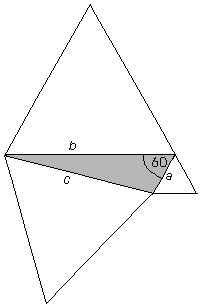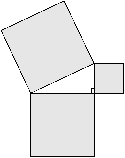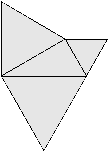Eutrigon Theorem - algebraic form
This web page is reproduced from the author's book Principles of nature; towards a new visual language, WA Roberts P/L Canberra. 2003.pp.126—127 [Used with permission of the author] edited and reformatted for the web.
The geometric form of the Eutrigon theorem states: the area of any eutrigon is equal to the combined areas of the equilateral triangles on legs ‘a’ and ‘b’, minus the area of the equilateral triangle on its hypotenuse ‘c’. How can this be expressed algebraically, that is, as an equation?

A eutrigon with equilateral triangles erected on all sides.
The algebraic form is now easy to find since we earlier determined the formulae for equilateral and eutrigonal areas in terms of etu. The area of an equilateral triangle (in etu) of side p is simply p2. And, the area of a eutrigon in etu is simply ab (the product of its leg lengths). This means that, expressed in etu, the Eutrigon Theorem can be restated as:
ab = a2 + b2 – c2
where a and b are the leg lengths of a eutrigon, and c is the length of its hypotenuse. Most importantly, in light of the new geometric form of the theorem, the term ab is now seen to be equal to the area of the enclosed eutrigon given in the new equitriangular units (etu).
Note the similarities and differences between the Pythagorean and Eutrigon theorems (in equation form):

In any right triangle [as illustrated above], a2 + b2 = c2
where a and b are the legs (sides adjacent to the right angle) and c, the hypotenuse. (This is Pythagoras' Theorem)
In any eutrigon [as shown above], a2 + b2 – ab = c2
where a and b are the legs (sides adjacent to the 60° angle) and c is its hypotenuse (side opposite the 60° angle). This, I am calling, the ‘Eutrigon Theorem’, and this is its alternative algebraic form.
Some mathematically-inclined readers may recognise this algebraic form of the Eutrigon theorem as simply the Cosine Rule for the special case when angle C equals 60-degrees. In other words, we have found that the ‘relative unit’ (the etu) is consistent with the Cosine Rule. This 'return to familiar territory' from the newer perspective of relative units or of related self-similar shapes which fit together without gaps to form wholes, and not merely from the older more rigid perspective of square units, lends support to the new reasoning. We expect new resonant ideas to be connected in harmonious ways with other parts of mathematics.
The Cosine Rule |
|
The Cosine Rule connection
The algebraic form of the Eutrigon Theorem, like the algebraic form of Pythagoras' Theorem, is indeed a special case of the Cosine Rule... When angle C is 90° , cosC = 0, and the Cosine Rule reduces to Pythagoras’ Theorem, c2 = a2 + b2. When angle C is 60°, cosC = 0.5, and the Cosine Rule reduces to the Eutrigon theorem, c2 = a2 + b2 – ab.
In our traditional ‘pull back’ way of thinking and of seeing the bigger picture, we might view the Cosine Rule as superseding the Pythagorean and Eutrigon theorems, since it seems to generalise them to include any triangle shape. This may be so, but only from one point of view. From the perspective of scale-structure theory we look at the situation quite differently. The Cosine Rule includes a spectrum, a continuum of possible triangles. It is like a space. But the Pythagoras and Eutrigon theorems are like points which together form asymmetrically balanced divisions and connections within that space. In a way, these special ‘points’ (or theorems for the specific instances of the Cosine Rule in which angle C = 90° and 60° respectively), are akin to ‘centres of gravity’ which relate to (and reflect the properties of) the virtual space within which they exist. They are members of a scale structure. They are like harmonics on a vibrating string.
It may nonetheless be maintained by some that the Eutrigon theorem is merely a reiteration of the Cosine Rule for a particular value of angle C.
If this is so, the same reasoning applies to Pythagoras’ theorem . But there would be few mathematicians who would question the continuing importance of Pythagoras’ theorem not only to geometry, but to number theory, trigonometry, and more mathematics and science than bears mentioning.
In the history of science progress has been constrained not so much by what has been observed but in how it has been interpreted. Preconceived attitudes and assumptions have always coloured humankind’s account of how and why things are the way they are. Copernicus observed the same celestial motions as his contemporaries but drew very different conclusions from them.
New harmonies of number and geometry
The geometric form of the Eutrigon theorem offers a new spatial and Pythagoras-like understanding of the Cosine Rule when angle C = 60°. Certainly we previously knew that when angle C = 60°, the Rule gave us the equation c2 = a2 + b2 – ab, but we could make neither head nor tail of this before in terms of shapes and areas (only in terms of lengths). If we had tried to interpret this in terms of areas and shapes the traditional (and current) approach would be to try to represent the algebraic terms (a2 , ab, and so on) as squares and rectangles—squares constructed on the legs and hypotenuse of the eutrigon, and, somehow fitting into the scheme of things, a rectangle (represented by the term ‘ab ’). Whilst the equation holds true for these more familiar orthogonal shapes and units of area, the connection to a triangle with one 60-degree angle seems remote. No wonder we stuck doggedly to the algebra here and gave a wide berth to the geometry! But now, with the benefit of relative units , we can see what this equation represents through new eyes. Through the geometric form of the Eutrigon theorem, everything is seen to fit into place extremely simply and beautifully...
Another point needs to be made in regard to the question of 'redundancy'. Although the Cosine Rule is inclusive of Pythagoras' theorem, it has not made the latter redundant. On the contrary, Pythagoras' Theorem remains to this day as one of the most widely used and useful theorems in all of mathematics. It is a resonant point within the Cosine Rule — a 'sweet-spot' on the Cosine-Rule racquet. But scale-structure theory suggests the Eutrigon Theorem ought to be as 'resonant' as that of Pythagoras, and it therefore ought to enjoy a comparably broad potential in its application and significance.
The special classes of triangle that are addressed by the Pythagoras and the Eutrigon theorems are like harmonics on the vibrating Cosine-Rule string.

These special frequencies allow ‘standing waves ’ to be set up on that string since their 'wavelengths' (or proportions) divide its length whole-numbers-of-times. In a musical manner of speaking, the somewhat cryptic looking term ‘2abcosC’, which for most triangles is some 'dissonant' irrational note (number), becomes harmonious (whole or integral) only for certain values of the identifying angle C [see diagram above] . And these angles are found to correspond to the internal angles of the regular polygons which tile the plane ... How beautiful is the dovetailing of these scale-structures! Not only do the Pythagoras and Eutrigon Theorems represent special cases in which 2cosC equals zero or one respectively, but they are instances of the Cosine Rule which have resonant geometries, in the sense that their associated symmetric and semi-symmetric geometric shapes can combine to tile the plane without gaps, and this resonant form of division of a domain or field into symmetric and/or semi-symmetric parts which together form logical wholes is the sine qua non of resonant scale structure.
Each of these ‘harmonic points’ is special in its own way.
 Pythagoras' Theorem
Pythagoras' Theorem
Whilst the Pythagorean Theorem boasts a slightly greater economy of terms than the Eutrigon Theorem (ET), the latter contains an important area not included in the former: the area enclosed or swept out by the three points of the triangle in question, in this case, the eutrigon [compare figures above and below].
 Eutrigon theorem
Eutrigon theorem
This small point of difference may prove to be extremely useful in the fullness of time. One is reminded of Kepler's Second Law of planetary motion: planets sweep out equal areas in equal times. It is conceivable that the Eutrigon theorem may well ultimately reveal new ‘harmonics’ at play in physical laws such as the second law of Kepler, and in many other phenomena in physics, cosmology, biochemistry, number theory, and perhaps new realms of science that may yet remain to be discovered and charted.
| Seen this way the special classes of triangle that relate to the Pythagorean and Eutrigon theorems are comparable to the harmonics and special intervals of sound that are so artfully combined in music.
|
|
| back to top |
next > |

